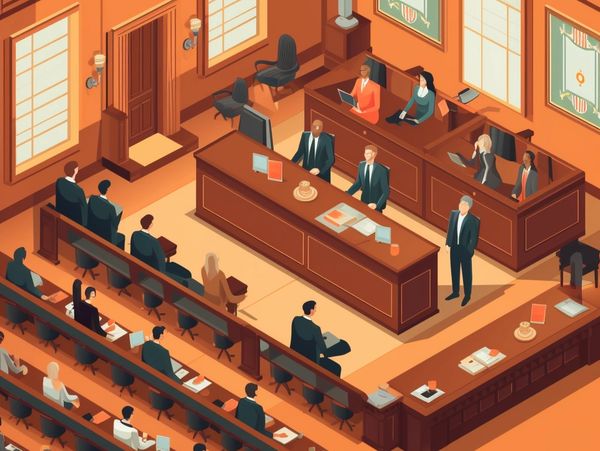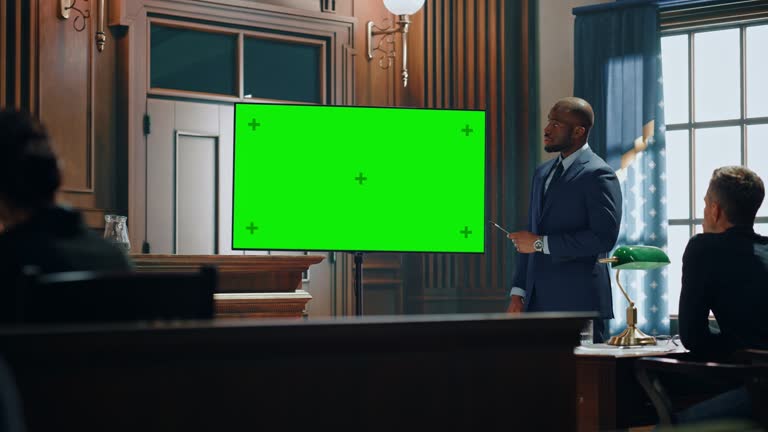Achieving Success in Courtroom Trials: The Importance of Professional Trial Presentations
Achieving Success in Courtroom Trials: The Importance of Professional Trial Presentations
Blog Article
Browsing the Complexities of Test Presentations: Tips for Seamless Shipment and Engaging Disagreements
In the realm of legal proceedings, the art of trial discussion stands as an important determinant of success. As lawyers browse the complex internet of court characteristics, the ability to flawlessly deliver disagreements and evidence while mesmerizing the court's attention ends up being paramount. The complexities integral in trial discussions call for a delicate balance of ability, approach, and finesse. By refining strategies that ensure a refined shipment and crafting engaging arguments that resonate with the audience, lawyers can significantly improve their campaigning for. In a globe where persuasion rules supreme, understanding the intricacies of trial presentations is not simply an alternative yet a need for those seeking to prevail in the courtroom.

Recognizing Trial Goals
To effectively navigate a test, it is critical to have a clear understanding of the objectives that require to be achieved. Before stepping right into the court, legal teams should define their goals and preferred outcomes. These objectives work as guiding concepts throughout the test, shaping strategies and influencing decision-making procedures.
Understanding trial objectives involves a comprehensive evaluation of the situation, legal criteria, and the client's best passions. Trial Presentations. It needs a careful examination of the realities, recognizing key concerns, and anticipating possible challenges. By establishing particular and quantifiable goals, lawyers can tailor their presentations and disagreements to align with the desired results
Additionally, a clear understanding of test objectives enables lawful teams to prioritize proof, witnesses, and legal debates effectively. It permits the growth of a coherent story that reverberates with the judge and court, reinforcing the general case discussion.

Organizing Evidence Efficiently
Having a clear understanding of test objectives lays the structure for organizing proof efficiently in lawful procedures. By aligning the discussion of evidence with the preferred outcomes of the test, lawful groups can strengthen their disagreements and improve their persuasiveness.
Another crucial element in organizing proof successfully is developing a rational flow. Presenting proof in a consecutive and systematic fashion can assist construct a compelling story that sustains the legal disagreements being made. Additionally, utilizing aesthetic aids such as graphes, timelines, or graphs can further improve the company of proof and assist in clearing up intricate relationships or series of occasions.
Furthermore, making sure that all proof presented is acceptable and appropriate to the case is necessary. Irrelevant or inadmissible evidence can detract from the stamina of the debate and possibly damage the trustworthiness of the providing event. A careful testimonial and option procedure must be embarked on to consist of just the most impactful and lawfully audio evidence in the trial presentation.
Crafting Persuasive Stories
Crafting compelling stories plays a pivotal duty in providing persuasive disagreements during lawful proceedings. When creating a narrative for a test presentation, it is crucial to establish a clear story that highlights crucial factors and links them in a systematic way. By weaving with each other evidence, testament, and legal debates into a convincing and natural narrative, lawful professionals can successfully advocate for their clients and raise the possibility of a desirable outcome in the court.
Mastering Visual Help
Reliable use aesthetic help is key to enhancing the impact and clarity of test discussions. Visual help, when made use of strategically, browse around this web-site have the power to streamline intricate information, reinforce crucial factors, and leave a lasting perception on the discretionary. To understand visual aids in trial discussions, it is critical to ensure that they are clear, concise, and appropriate to the debates being made.
When including aesthetic aids, such as charts, pictures, timelines, or charts, right into a test discussion, it is important to keep them visually appealing yet professional. The visuals ought to match the verbal disagreements, offering a visual representation of the info being talked about without overwhelming the audience with unnecessary details.
Moreover, exercising with the visual help ahead of time is essential to guarantee a seamless distribution throughout the test. Familiarizing oneself with the material, transitions, and timings of each visual help can aid keep the circulation of the presentation and prevent technical problems that might develop.
Providing Impactful Closing Disagreements
A compelling closing disagreement serves as the conclusion of a trial presentation, enveloping the core narrative and encouraging the judge and court towards a positive choice. Begin by detailing the major disagreements that sustain your client's setting, stressing why the evidence offered throughout the test supports your story.
Moreover, integrating psychological appeal can additionally strengthen your closing argument. By linking and humanizing the instance on an individual level with the decision-makers, you can evoke compassion and understanding, affecting their perception of the truths offered. Additionally, restating the lawful criteria that have to be met for a beneficial judgment can enhance the validity of your position. Eventually, a well-crafted closing disagreement need to leave a lasting impression, compelling the judge and court to regulation in your customer's support.
Conclusion
Finally, mastering trial discussions entails understanding purposes, arranging proof, crafting stories, making use of aesthetic help, and providing impactful closing disagreements. By executing these techniques efficiently, attorneys can present their case seamlessly and make engaging debates in the court. It is vital to navigate the complexities of test discussions with accuracy and skill to achieve success in lawful process.
By lining up the presentation of evidence with the wanted results of the trial, legal groups can enhance their arguments and enhance their persuasiveness (Trial Presentations). To understand visual aids in test presentations, it is essential to ensure that they are clear, succinct, and appropriate to the arguments being made
An engaging closing disagreement serves as the end result of a trial presentation, enveloping the core story and convincing the judge and jury in the direction of a positive decision. Begin by laying out the check my reference primary arguments visit here that sustain your client's placement, highlighting why the evidence provided throughout the trial sustains your narrative.In verdict, mastering test presentations entails comprehending purposes, organizing proof, crafting narratives, making use of visual help, and delivering impactful closing debates.
Report this page